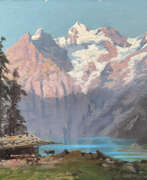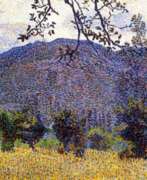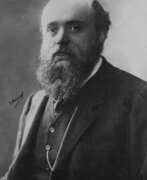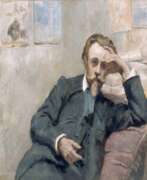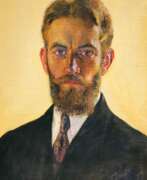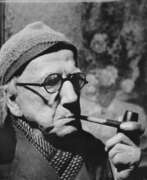Pointillism 20th century


Charles Angrand was a French painter and draftsman known for his Pointillist style and depictions of rural life. Born in Normandy, Angrand moved to Paris in his youth to study art. He was initially influenced by the Realist and Impressionist movements, but later developed his own style of Pointillism, which he applied to landscapes, cityscapes, and genre scenes.
Angrand's Pointillist technique involved the use of small, distinct dots of color that, when viewed from a distance, blended together to create the impression of a more vibrant and luminous image. His work often focused on the people and landscapes of rural France, and he was particularly interested in the effects of light and atmosphere on his subjects.
Angrand exhibited his work at many important exhibitions, including the Salon des Indépendants and the Salon d'Automne in Paris. He was also involved in the Neo-Impressionist movement, which sought to explore the scientific principles of color and optics in painting.
Despite his contributions to the development of Pointillism, Angrand's work was largely forgotten after his death, and it was not until the mid-20th century that he began to be rediscovered by art historians and collectors. Today, his paintings are represented in many important collections, including the Musée d'Orsay in Paris and the Art Institute of Chicago.


Yvonne Canu was a French painter and neo-impressionist who used pointillism and divisionism in her work. She studied at the Ecole des Arts Décoratifs in Paris and the Académie de la Grand Chaumiere.
Yvonne Canu's paintings were mainly landscapes and still lifes. Her works displayed a meticulous attention to detail and an emphasis on capturing the effects of light and colour. Using pointillism, she achieved a luminous quality in her paintings, with colours optically blending into one another when viewed from a distance.


Henri Edmond Cross, a French painter and printmaker, emerged as a pivotal figure in the Neo-Impressionism movement, significantly influencing the realm of modern art. His work, celebrated for its innovative use of color and technique, played a crucial role in transitioning from Pointillism to broader, more expressive brushstrokes, marking a departure from strict naturalism. This evolution allowed for greater personal expression and creativity, profoundly impacting artists like Henri Matisse, who was inspired by Cross's harmonious representations of Arcadian landscapes.
Cross's paintings, characterized by their vibrant color harmonies and lyrical emotion, encapsulate the artist's desire to portray utopian ideals, often reflecting his anarchist beliefs in a hopeful, ideal society. His works, such as "L'air du Soir" and "La Plage de Saint-Clair," showcase his mastery of light and color, embodying the Neo-Impressionist vision of creating harmonies of pure color independent of naturalistic constraints. These pieces not only exemplify Cross's technical prowess but also his philosophical aspirations, intertwining art with social and political ideals.
Despite the challenges posed by his health in later years, Cross's productivity and creativity remained undiminished, leading to significant critical acclaim and commercial success. His solo exhibitions, particularly the one held at Galerie Druet in Paris in 1905, received widespread acclaim, underscoring his influence on the art world and his role in shaping the principles that would guide future movements such as Fauvism.
For collectors and experts in art and antiques, Henri-Edmond Cross's work represents a crucial juncture in the evolution of modern art, offering insights into the transition from the meticulous dots of Pointillism to the expressive freedom of later movements. His legacy is preserved in esteemed institutions like the Musée d'Orsay, where his masterpieces continue to inspire admiration and study.
For those interested in the intersection of art, culture, and history, signing up for updates on sales and auction events related to Henri-Edmond Cross can offer valuable opportunities to engage with the vibrant legacy of this influential artist. This subscription ensures access to the latest offerings and insights into the world of Neo-Impressionism, inviting enthusiasts to deepen their appreciation for Cross's contribution to modern art.


Alfred William (Willy) Finch was a ceramist and painter in the pointillist and Neo-Impressionist style. Born in Brussels to British parents, he spent most of his creative life in Finland. In 1883 he became a founding member of Les XX, a group of twenty Belgian painters, designers and sculptors, who rebelled against the prevailing artistic standards and outmoded academism. He was impressed by the works of Georges Seurat and Paul Signac and changed his own painting style from a more realistic approach into a pointillistic style. In the following years, Finch became one of the leading representatives of his style in Belgium, along with Théo van Rysselberghe. During the early 1890s Finch switched careers from painting to pottery, upon the realization that he couldn't make a living by painting. In 1897, invited by count Louis Sparre, Finch moved to Porvoo, Finland, to head the Iris ceramics factory, and influenced the development of the local Jugendstil. After the factory was closed, Finch resumed his painting career.


Gustav Gildemeister was a German artist, a representative of the avant-garde movements of the early twentieth century.
He studied art at the Dusseldorf Academy, painted portraits and mainly landscapes in the styles that were actively developing at that time: German Art Nouveau, French Pointillism and late Impressionism. The artist was drafted during World War I and died at the front.


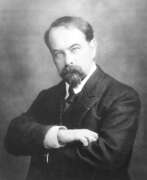

Henri Eugène Le Sidaner was a French painter known for his intimate, atmospheric landscapes and still-life paintings. He was born in Port Louis, Mauritius, but grew up in northern France and studied art at the École des Beaux-Arts in Paris.
Le Sidaner's early work was influenced by the Impressionists, but he later developed his own distinctive style characterized by a subdued palette, soft brushwork, and a focus on capturing the effects of light and atmosphere. His paintings often depict gardens, parks, and rural landscapes, as well as interiors and still-life arrangements.
Le Sidaner was also known for his use of light and shadow, which he used to create a sense of depth and mood in his paintings. He was particularly interested in the way that light and shadow interacted in interior spaces, and many of his paintings depict quiet, contemplative scenes bathed in a soft, diffuse light.
Le Sidaner's work was widely exhibited during his lifetime, and he received many awards and honors, including the Legion of Honor in France. His paintings are now included in many important collections, including the Musée d'Orsay in Paris and the Metropolitan Museum of Art in New York.


Georges Lemmen is a Belgian Neo-Impressionist painter, member of the XX Society. He was close to art from childhood and studied for a time at a special drawing school. In the early 1880s, as a teenager, he was introduced to the work of Edgar Degas and Henri Toulouse-Lautrec, which had a great influence on him.
Georges Lemmen's paintings were marked by the use of fine, clean strokes and a vivid colour palette. He used the technique of divisionism, applying strokes of pure colour in close proximity to one another to create a sense of optical blending and luminescence.
Lemmen's subject matter was varied: landscapes, portraits, interiors and scenes of everyday life. He often portrayed leisurely pursuits and the beauty of nature, infusing his work with a sense of tranquillity and harmony.
Until 1895, he abandoned pointillism to contribute to the development of Belgian Art Nouveau. He created many book illustrations, posters, ceramics, carpets, drawings, pastels and gouaches in this style.


Gustave Loiseau was a French artist known for his landscapes and scenes of the Parisian streets.
In 1890, Gustave Loiseau first travelled to Pont-Aven in Brittany, where he met Paul Gauguin and Emile Bernard. Having experimented with pointillism, he adopted his own approach to post-impressionism, painting landscapes directly from life. His technique, known as en treillis or cross-hatching, gave his works a special quality.
Gustave Loiseau's paintings, which reveal his passion for the seasons from the early spring to the late autumn harvest, often depict the same garden or garden scene over time. Series of this kind, which also include cliffs, harbours or churches, are reminiscent of Claude Monet.


Henri-Jean Guillaume Martin was a French painter. Elected to the Académie des Beaux-Arts in 1917, he is known for his early 1920s work on the walls of the Salle de l'Assemblée générale, where the members of the Conseil d'État meet in the Palais-Royal in Paris. Other notable institutions that have featured his Post-Impressionist paintings in their halls through public procurement include the Élysée Palace, Sorbonne, Hôtel de Ville de Paris, Palais de Justice de Paris, as well as Capitole de Toulouse, although the Musée des Beaux-Arts de Bordeaux and Musée des Augustins also have sizeable public collections.


Nikolai Vasilievich Mescherin (Russian: Николай Васильевич Мещерин) was a Russian artist and entrepreneur born on February 28, 1864, in Moscow, and died on October 22, 1916, in Meshcherino, Russia. Known primarily for his landscape paintings, Mescherin initially embraced Impressionism, later experimenting with Pointillism, a technique developed by French Neo-Impressionists. His lyrical landscapes, often rendered in pastel, capture the serene beauty of Central Russia.
Mescherin was also a co-owner of the Moscow Danilovskaya Manufactory, balancing his industrial pursuits with his artistic endeavors. His works are significant for their emotional depth and technical precision, distinguishing him in the Russian art scene of the late 19th and early 20th centuries. Some of his notable works are housed in the Museum of Russian Impressionism in Moscow, where they continue to attract admiration from art enthusiasts and collectors.
For those interested in exploring more about Nikolai Vasilievich Mescherin's life and works, signing up for updates on new product sales and auction events related to his art is highly recommended. Stay informed about the latest opportunities to acquire pieces from this remarkable artist's collection.


George Morren or Georges Morren was a Belgian painter, sculptor, Impressionist and engraver. The painter and friend of the family Emile Claus who taught him and his brothers several times a week served as his first mentor. He began working in an Impressionist style. In the summer of 1892, eschewing the shortened painting process which was associated with Neo-Impressionism, he began to work in a more spontaneous manner, creating more space for emotions. He became one of the most eager admirers of the French Impressionists. After three years in Paris he returned to Antwerp where he participated in several avant-garde groups. Morren created light-flooded paintings, exhibited at the fairs La Libre Esthétique in Brussels, the 'Vie et Lumière', and at numerous international exhibitions. Towards 1913, he entered a new creative period. The colors in his new works were more subdued. He used grated rough pigment and pastels. Morren remained faithful to impressionist ideals and did not participate in new trends, such as Cubism or Expressionism. He dealt with the scenes of everyday life, interiors, still lifes, landscapes and portraits. His palette became darker and his paintings developed a solemnity and clarity of expression.
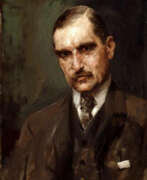

Hans Olde was a German painter of the late nineteenth and early twentieth centuries. He is known as an impressionist painter and graphic artist, as well as a teacher and administrator.
Olde produced images of people, animals, landscapes, portraits and genre paintings, experimenting with pointillism. He was one of the founders of the Munich Secession and directed the Saxon Higher School of Art in Weimar. In 1911 the master became head of the Academy of Art in Kassel, playing an important role in the development of both the Weimar and Kassel academies, introducing reforms in the teaching process and supporting the admission of women artists. Olde had a significant influence on the development of the art of his time.


Charles Johann Palmié was a German painter, one of the pioneers of German Modernism and Neo-Impressionism.
He studied at the Dresden Academy of Fine Arts, traveled and worked extensively, specializing in landscapes. In 1901 Palmie and his artist wife opened an artists' hotel in Kalmunz, Germany. Soon an entire colony of artists formed there, numbering up to forty people, many of whom lived there permanently. After Wassily Kandinsky and Gabriele Münter visited the hotel in the summer of 1903, the Kalmunz colony became the talk of the art world.
Impressed by the works of Claude Monet, the artist traveled to France in 1905, where a meeting with the master himself played a decisive role in the further direction of Palmie's work. In France, he spent much time studying Neo-Impressionism, pointillism and monochrome painting, and created many landscapes.
In 1909 Palmie, along with Vasily Kandinsky, Alexei Jawlensky, Gabriele Münter and others, became one of the founders of the Association of New Artists of Munich (Neue Künstlervereinigung München or NKVM), an expressionist art group in Munich. This group later evolved into Der Blaue Reiter ("The Blue Rider"), but without Palmie's participation.


Alexandre Perrier was a Swiss landscape painter; mostly of Alpine mountain scenes. He also created a few portraits.
His early paintings use a Pointillistic technique, but his later ones show a broader brushstroke. He did not follow the general practice of painting en plein aire, preferring to make sketches on site and producing the canvases in his studio.


Hippolyte Petitjean was a French Neo-Impressionist painter of pointillism.
Hippolyte studied at the School of Fine Arts in Paris, where he became interested in Impressionism. He then mastered the Neo-Impressionist technique of pointillism to perfection. A close friend of Georges Serat, Petitjean regularly exhibited with fellow practitioners. Although he abandoned working with divided color for a few years, he resumed the pointillist technique around 1912, creating luminous watercolors. In his later watercolors, Petitjean used widely spaced circular dots of pure color, leaving much of the surface of the paper untouched.
Petitjean painted landscapes and portraits, still lifes and genre scenes.


Maurice Brazil Prendergast was an American post-Impressionist painter known for the vibrant and saturated colors he used in his work, mostly in the genre of landscape and urban life. In 1886 Prendergast moved to Paris, where he studied at the École Julien under the tutelage of the masters of Impressionism, including Paul Cézanne, who had a great influence on Prendergast's style.
After his return to the United States in 1891, Prendergast became a popularizer of Impressionism in the United States. His work became brighter and more saturated in color than other American artists of the time, and he began to use a dotted style similar to the technique of divisionism. His paintings became similar to tapestries or mosaics.
Prendergast became a member of a group of artists known as the Founders of American Art, who advocated the use of bright and saturated colors instead of the muted and earthy tones adopted in traditional American art. Prendergast left behind a legacy that laid the foundation for the development of Post-Impressionism and Modernism in American art.


Jean Puy was a French painter associated with the Fauvist movement, known for his colourful and colourful works.
Jean Puy's early work was influenced by Impressionism, but he later adopted the bold and expressive use of colour characteristic of Fauvism. Inspired by artists such as Henri Matisse and André Derain, Puy developed a unique style that emphasised the emotional and decorative qualities of colour.
Puig's paintings often depicted landscapes, still lifes and scenes of everyday life. He was particularly interested in conveying the effects of light and colour in his works, using intense and unnatural colours to show mood and expression.
During his career, Puig exhibited at the Salon d'Autumn and the Salon des Artistes Indépendants, which were important exhibitions of avant-garde art in Paris.


Théo van Rysselberghe, a prominent Belgian painter, was a key figure in the Neo-Impressionist movement, particularly known for his adoption of the pointillist technique. Born in Ghent, Belgium, in 1862, van Rysselberghe played a crucial role in the artistic circle Les XX, a group of avant-garde artists who sought to break away from traditional academic art norms. His early works displayed an Impressionist influence, which evolved significantly after he encountered Georges Seurat's pointillist masterpiece at an Impressionist exhibition in Paris in 1886.
Van Rysselberghe's career saw a significant shift after this encounter, as he embraced pointillism, a technique involving the application of small, distinct dots of color to form an image. His mastery in this style is evident in his landscapes and portraiture, where he employed vibrant colors and meticulous attention to light and detail. His work during this period is considered the pinnacle of his artistic achievements, showcasing his talent not only in landscapes but also in pointillist portraiture, a genre he significantly contributed to within the Neo-Impressionist movement.
Despite his success and contributions to pointillism, Théo van Rysselberghe eventually moved away from this technique around 1904, exploring other artistic expressions. Throughout his career, he remained an influential figure in the Belgian art scene, his works continuing to inspire and attract attention for their innovative approach and technical prowess.
For art collectors and enthusiasts, delving into Théo van Rysselberghe's oeuvre offers a fascinating glimpse into the evolution of Neo-Impressionism and pointillism, highlighting the artist's significant role in these movements. To stay updated on sales and auctions featuring van Rysselberghe's works, signing up for updates can provide exclusive insights into opportunities to acquire pieces by this remarkable artist.


Jeanne Selmersheim-Desgrange was a French Neo-Impressionist painter who used the art technique of pointillism in her paintings. She was a pupil of Paul Signac.
Jeanne Zelmersheim-Desgrange's art was influenced by Symbolism, a movement that sought to convey emotions, dreams and spiritual themes through visual images. She experimented with bright colours and bold brushstrokes, capturing the essence of her subjects and conveying a sense of energy and emotion.


Paul Signac, a French Neo-Impressionist painter, played a pivotal role in the development of the Pointillist style alongside Georges Seurat. Born on November 11, 1863, in Paris, Signac's artistic journey was marked by significant collaborations and encounters, including meeting Vincent van Gogh and Toulouse Lautrec in Paris. His relationship with van Gogh was notably influential, as they painted together at Asnières-sur-Seine, focusing on river landscapes and cafés.
Signac was deeply invested in anarchist ideas, which he explored through his readings of Élisée Reclus, Kropotkin, and Jean Grave. His political leanings were also evident in his art, as seen in his 1893 painting, "In the Time of Harmony," which was initially titled "In the Time of Anarchy." This change was necessitated by the political repression of anarchists in France at the time.
A lover of sailing, Signac began traveling in 1892, which greatly influenced his art. He would sail to various ports, bringing back vibrant watercolors sketched from nature. These sketches later served as the basis for his larger studio canvases, which were composed of small, mosaic-like squares of color, differing from Seurat's tiny, variegated dots.
Signac's contribution to art extended beyond his own works. As president of the Société des Artistes Indépendants from 1908 until his death, he encouraged younger artists and exhibited controversial works of the Fauves and Cubists. He was notably the first patron to buy a painting by Henri Matisse, demonstrating his support for emerging artists.
In his personal life, Signac married Berthe Roblès on November 7, 1892, and his interactions with other artists, including Henri Matisse and André Derain, were instrumental in the evolution of Fauvism. Despite initially not admiring the Fauve style, Signac played a decisive role in its development.
Signac's impact on culture, art, and painting is undeniable. His works, found in various museums and galleries, continue to inspire art collectors and experts. For those interested in exploring Signac's contributions further, signing up for updates on new product sales and auction events related to Paul Signac is highly recommended. This subscription is an excellent way for collectors and art experts to stay informed about the latest developments and opportunities related to Signac's enduring legacy.


Fernand Verhaegen was a Belgian painter and etcher. He took courses at the Académie Royale des Beaux-Arts from 1900 to 1906. After graduation, he exhibited his works in Belgium and abroad. His style gradually evolved from impressionism and Belgian luminism to a synthetic form of capturing reality. In his later years, he came back to a personal form of impressionism. Verhaegen specialized in painting Walloon folklore. Verhaegen's works are in many museums of Belgium and abroad.


Edmond Paul Marie Verstraeten was a Belgian painter and etcher. He was a luminist impressionist and painted mainly landscapes, but also still lifes and portraits. As a philosophically inclined non-conformist, Verstraeten painted in the direction of pointillism, impressionism and luminism. As a self-taught artist, he had developed his own style, which art critics classed as luminist impressionism. He was a master at painting the light and snow. He was part of the third generation of the School of Tervuren and Genk School. He also wrote poems.




